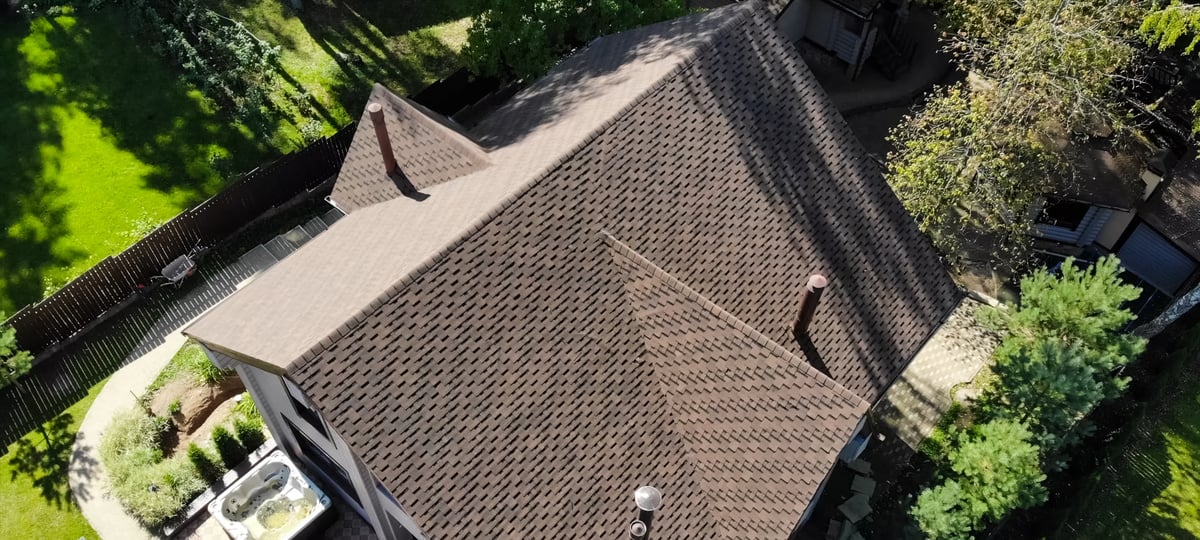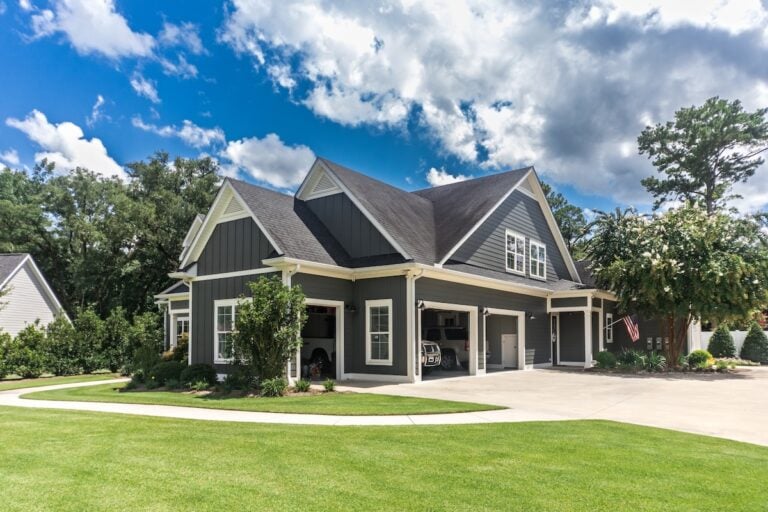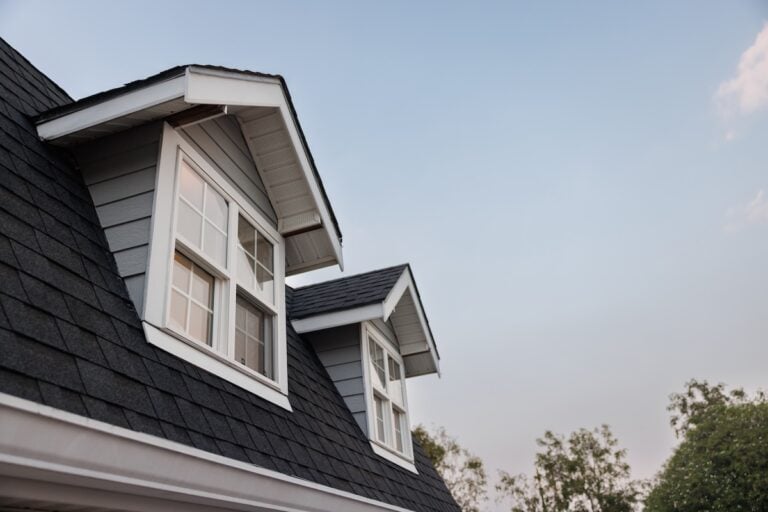Your roof is one of the most critical components of your home, protecting you and your belongings from the elements. Understanding the lifespan of your roof and recognizing when it needs replacement is essential for maintaining your home’s integrity. When you’re wondering “How long does a roof last?”, look no further than this detailed guide. To make it easy to understand roof longevity, we’ve included the following in this guide:
- Warning signs
- Factors affecting lifespan
- Warranties
- Comparisons of materials
- 7 steps you can take to improve the lifespan of your roof
- Maintenance tips.
❌ Warning Signs You Need a New Roof
Recognizing the early signs of roof damage can save you from more extensive and expensive repairs down the line. Here are some key indicators that your roof may need replacement:
- Age: The age of your roof is a significant factor. Most roofs last between 20 to 30 years, depending on the material. If your roof is approaching or has surpassed this age, it might be time for an inspection.
- Shingle Damage: Look for cracked, curled, or missing shingles. These are signs that your shingles are deteriorating and can no longer protect your home effectively.
- Granule Loss: If you notice granules from your shingles in your gutters, it’s a sign that your roof is losing its protective layer, reducing its effectiveness.
- Leaks and Water Damage: Water stains on your ceiling or walls indicate that your roof may have leaks. Even small leaks can lead to significant damage over time.
- Sagging Roof Deck: If you notice any sagging areas on your roof, it could mean that there’s a structural issue, often caused by prolonged water damage.
- Moss and Algae Growth: While not always a sign of immediate danger, moss and algae can cause shingles to deteriorate faster.
- Daylight Through Roof Boards: If you can see sunlight coming through the roof boards from your attic, it’s a clear indication that your roof needs attention.
👉 Factors That Can Impact the Lifespan of Your Roof
Several factors influence how long your roof will last. Understanding these can help you make informed decisions about roof maintenance and replacement.
- Climate: Harsh weather conditions, such as extreme heat, cold, heavy rainfall, snow, and hail, can significantly reduce your roof’s lifespan. UV rays from the sun can also degrade roofing materials over time.
- Roof Material: Different roofing materials have varying lifespans. Asphalt shingles, metal, tile, and wood each have their own durability levels and maintenance needs.
- Installation Quality: A well-installed roof by experienced professionals will last longer and perform better than one installed poorly. Proper installation ensures that the materials are fitted correctly and can withstand environmental stressors.
- Ventilation: Proper attic ventilation is crucial. Without it, heat and moisture can build up, leading to mold growth and deterioration of the roof structure.
- Maintenance: Regular maintenance, including inspections and repairs, can extend your roof’s lifespan. Neglecting minor issues can lead to significant problems over time.
- Roof Slope: The pitch of your roof affects its ability to shed water and resist wind damage. Steeper roofs typically last longer because they allow water to run off more efficiently.
💵 How Warranties Compare to the Lifespan of a Roof
Roof warranties are designed to provide homeowners with peace of mind, but it’s essential to understand what they cover and how they compare to the actual lifespan of your roof.
- Manufacturer’s Warranty: This warranty covers defects in the roofing materials. It can range from 20 to 50 years, depending on the material and manufacturer. However, it doesn’t cover installation errors or damage from external factors.
- Workmanship Warranty: Provided by the roofing contractor, this warranty covers issues arising from improper installation. These warranties typically last from 2 to 10 years, depending on the contractor.
- Prorated vs. Non-Prorated Warranties: Prorated warranties cover less as the roof ages, meaning you’ll pay more out of pocket for repairs or replacements over time. Non-prorated warranties provide full coverage for the entire warranty period.
- Maintenance Requirements: Most warranties require regular maintenance and inspections to remain valid. Neglecting these requirements can void your warranty.
🧰 How Long Roofs Last by Their Materials
The type of roofing material you choose significantly affects how long your roof will last. Here’s a breakdown of the average lifespans of various roofing materials:
- Asphalt Shingles: These are the most common roofing material due to their affordability and ease of installation. They typically last 20 to 30 years, with higher-quality architectural shingles lasting up to 40 years.
- Metal Roofing: Metal roofs are durable and can last between 40 to 70 years. They are resistant to extreme weather conditions and require minimal maintenance.
- Wood Shingles and Shakes: These roofs have a natural aesthetic and can last 25 to 30 years with proper maintenance. However, they are susceptible to fire and water damage.
- Clay and Concrete Tiles: These materials are incredibly durable, with lifespans ranging from 50 to 100 years. They are resistant to fire and can withstand harsh weather but are heavy and may require additional structural support.
- Slate: Slate roofs are among the longest-lasting, with a lifespan of 75 to 100 years or more. They are extremely durable and low-maintenance but also expensive and heavy.
- Synthetic Roofing Materials: Materials like rubber, plastic, and polymer can mimic traditional roofing materials and typically last 20 to 50 years, depending on the quality.
🏬 Commercial vs. Residential Lifespan of Roofs
The lifespan of a roof can vary significantly between commercial and residential buildings due to differences in design, materials, and usage.
- Residential Roofs: These roofs typically use materials like asphalt shingles, wood, and tile. The average lifespan of a residential roof ranges from 20 to 50 years, depending on the material and maintenance.
- Commercial Roofs: Commercial buildings often have flat or low-slope roofs made from materials like EPDM, TPO, PVC, or modified bitumen. These materials have different lifespans:
- EPDM: 20 to 25 years
- TPO and PVC: 15 to 30 years
- Modified Bitumen: 10 to 20 years
- Maintenance: Commercial roofs often require more frequent maintenance due to their size and complexity. Regular inspections and repairs are crucial for maximizing their lifespan.
💡 7 Things a Homeowner Can Do to Improve the Lifespan of Their Roof
Proactive maintenance and care can significantly extend the life of your roof. Here are some steps homeowners can take:
1. Regular Inspections:
Conduct visual inspections of your roof at least twice a year and after major storms. Look for signs of damage or wear and tear.
2. Clean Gutters:
Keep gutters and downspouts clear of debris to ensure proper drainage and prevent water damage.
3. Trim Overhanging Branches:
Overhanging tree branches can damage your roof during storms and allow leaves to accumulate, which can retain moisture and promote rot.
4. Remove Moss and Algae:
Use a roof cleaner specifically designed for removing moss and algae. Avoid using a pressure washer, as it can damage shingles.
5. Address Leaks Promptly:
If you notice any signs of leaks or water damage, address them immediately to prevent further deterioration.
6. Proper Attic Ventilation:
Ensure your attic has proper ventilation to reduce heat and moisture buildup, which can damage your roof.
7. Professional Inspections:
Hire a professional roofer to inspect your roof every few years. They can identify and fix issues that may not be visible to the untrained eye.
🗓️ How Often a Roof Needs to be Replaced
The frequency of roof replacement depends on various factors, including the type of material, climate, and maintenance. Here are general guidelines:
- Asphalt Shingles: Replace every 20 to 30 years.
- Metal Roofing: Replace every 40 to 70 years.
- Wood Shingles and Shakes: Replace every 25 to 30 years.
- Clay and Concrete Tiles: Replace every 50 to 100 years.
- Slate: Replace every 75 to 100 years.
- Synthetic Roofing Materials: Replace every 20 to 50 years.
❓ FAQs
Q: Can I install a new roof over my old one? A: In some cases, it’s possible to install a new layer of shingles over an existing one, which can save time and money. However, this is only advisable if the underlying structure is in good condition and local building codes allow it.
Q: How much does a roof replacement cost? A: The cost of a roof replacement varies widely based on the material, size, and complexity of the roof. On average, homeowners can expect to pay between $5,000 and $10,000 for an asphalt shingle roof replacement, with costs increasing for higher-end materials like metal, tile, or slate.
Q: Is roof replacement covered by homeowners insurance? A: Homeowners insurance typically covers roof replacement if the damage is caused by a covered peril, such as a storm or fire. However, it may not cover replacement due to general wear and tear or lack of maintenance.
Q: How can I choose the best roofing material for my home? A: Consider factors such as your budget, climate, and the architectural style of your home. Consult with a professional roofer to determine the best material for your specific needs.
Q: What is the best time of year to replace a roof? A: Spring and fall are generally the best times for roof replacement, as the weather is mild. However, roofers can work year-round, so urgent replacements can be done as needed.
Q: Can I extend the life of my roof with regular maintenance? A: Yes, regular maintenance, including inspections, cleaning, and minor repairs, can significantly extend the lifespan of your roof and prevent costly replacements.
Your Trusted Roofing Team At Palladium Roofing
Understanding the lifespan of your roof and the factors that influence it can help you make informed decisions about maintenance, repairs, and replacements. Regular inspections and proactive care are essential for maximizing your roof’s longevity and protecting your home. By choosing the right materials and working with experienced professionals, you can ensure that your roof provides reliable protection for many years to come. Contact us today, and we’ll quickly connect with you to learn more about your specific needs so we can provide the best service possible.





